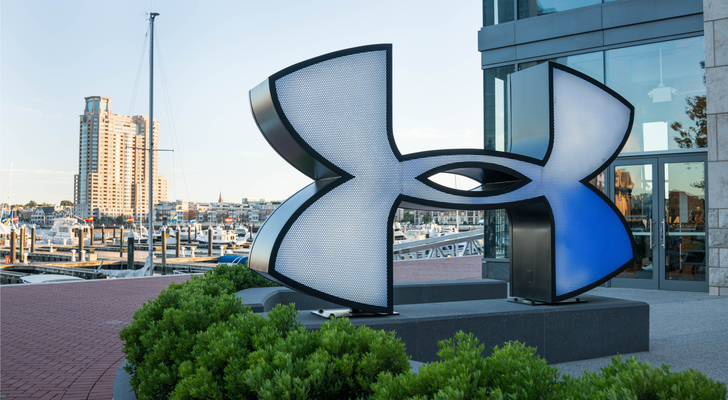Athletic retail brand Under Armour Inc (NYSE:UAA) just dropped the Project Rock 1 athletic sneakers, and they were a major hit. The shoes, which are a result of collaboration with Under Armour athlete and celebrity Dwayne “The Rock” Johnson, sold out within 30 minutes on Under Armour’s website.
That’s right. It took only 30 minutes for the Project Rock shoes to sell out everywhere. Shelves won’t be restocked until the end of June.
This is just the latest in a series of hits for Under Armour. The whole athletic retail environment is improving. The company’s North America business is stabilizing. International growth remains red-hot. NBA superstar and Under Armour athlete Stephen Curry is once again dazzling fans in the NBA Finals.
It seems like everything is coming together for Under Armour at the right time, and that is fueling robust optimism regarding this company’s turnaround potential. As a result, Under Armour stock is up 65% year-to-date, making it a top-5 performer in the S&P 500.
But I don’t buy the hype.
The only way Under Armour stock is worth anything near $25 today is if the company gets a big valuation like Nike Inc (NYSE:NKE) at scale. But Under Armour is no Nike. Nor will it ever be.
As such, I’m fading this rally in Under Armour stock. Here’s a deeper look.
The Bull Thesis on Under Armour Has Merit
The bull thesis supporting this bounce back in Under Armour isn’t completely powered by fairy dust.
The entire athletic retail environment is improving. Many pundits thought that the athleisure trend, which has dominated the retail scene for several years, was showing signs of wavering in 2017.
But they were wrong. Since then, everyone from Under Armour to Nike to Lululemon Athletica inc. (NASDAQ:LULU) has reported improved numbers. Clearly, the athleisure trend is only strengthening, and that does give firepower to the Under Armour bull thesis.
Meanwhile, Under Armour’s recent results do point to operational improvements. North America revenues are stabilizing. International revenues are up more than 20%. Margins look due for a bounce back and remain well off their five-year highs.
Elsewhere, catalysts point to these improvements continuing in the near future. Stephen Curry is dazzling fans in the NBA Finals, is making a solid case for NBA Finals MVP, and is arguably outperforming Nike’s basketball guy, LeBron James. Meanwhile, Dwayne Johnson is as popular as ever, evidenced by the Project Rock shoes selling out so quickly.
Overall, the bull thesis does have some merit.
The Bear Thesis Is Far More Accurate
But that merit collapses upon closer inspection.
Yes, the entire athletic retail environment is heating up, but Under Armour isn’t the reason why. Athleisure remains the trend in retail because brands like Nike, Adidas and Lululemon have pivoted from performance brands with niche appeal to lifestyle brands with broader appeal.
Under Armour hasn’t made that pivot, and while its Project Rock shoes give them an opportunity to do so, there aren’t any clear signs that Under Armour shoes are about to be commonplace off the court and off the field.
That is why, according to Google Trends, the popularity of Nike and Adidas has soared over the past five years, while Under Armour’s popularity started plateauing in early 2016 and hasn’t made a comeback since. Even amid recent Curry and Project Rock shoes catalysts, Under Armour search interest remains weak.
Moreover, whereas Nike and Adidas make appearances all over Piper Jaffray’s Taking Stock With Teens Spring 2018 survey as top clothing and footwear brands, Under Armour doesn’t make a single appearance. Anywhere.
From this perspective, the company’s recent operational improvements shouldn’t really be labeled as improvements. North America revenues are stabilizing, but the fact that there is no growth at such a small base is a big red flag for the international business. Indeed, international sales growth has cooled from up 57% a year ago to up 19% last quarter.
Let’s Talk Valuation
All things considered, Under Armour is no Nike.
Brand image is far weaker. Addressable market is smaller. Long-term sustainability and popularity are even bigger question marks.
But the only way Under Armour’s current price tag makes sense is if the stock gets a Nike-type valuation at scale. Here’s the math:
– Revenue growth in North America is flat and will remain so into the foreseeable future given increased competition and lack of lifestyle appeal.
– International revenue growth will keep falling and eventually stabilize at an early stage, much like what happened in North America.
– Overall revenue growth over the next five years will average out around 5% per year.
– Margins will eventually rebound, but Under Armour’s reliance on lower-priced channels like Kohl’s Corporation (NYSE:KSS) to drive sales will prevent margins from regaining peak levels.
– Operating margins will likely bounce to 7.5%, from 0.6% last year and versus 11%-plus highs earlier this decade.
– 5% revenue growth and 7.5% operating margins should lead to around $1.50 in earnings per share in five years.
– A Nike-average multiple of 25 times forward earnings multiple on $1.50 implies a four-year forward price target of $37.50 and present-day value of $25 (using 10% discount rate).
– A market-average multiple of 16 times forward earnings on $1.50 implies a four-year forward price target of $24 and present-day value of $16 (using 10% discount rate).
Overall, then, Under Armour’s present valuation makes sense only if you think that the stock will get a Nike-type multiple in five years. But considering Under Armour is no Nike, that is highly unlikely.
Bottom Line on UAA Stock
Under Armour stock is making a comeback. But the Under Armour brand is not. At around $24, the valuation on Under Armour stock doesn’t make much sense given low growth prospects, low brand image, and lack of visible catalysts to turn things around.
As of this writing, Luke Lango did not hold a position in any of the aforementioned securities.

